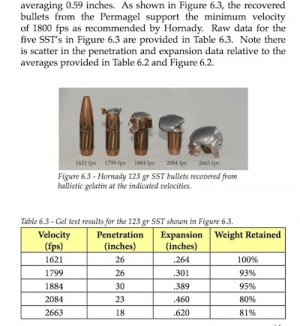Maybe an odd question. Maybe asked before, but my search-fu is not strong today.
The 95 gr V-Max is designed to have high velocity and a thin jacket; to almost explosively expand and stop fast in smaller thin-skinned game; to devastating effect on such sized game. OK Cool. But everyone says no good on deer, because doesn't penetrate as much as desired in that heavier game - at the velocities typical to that light bullet. Ok, makes sense.
And a heavier hunting bullet like a 123 gr SST, has a little thicker jacket and is designed to run a bit slower, but still fast, and expand more slowly, yet still fully; to do a better job on heavier game like deer and such. OK, makes sense.
Makes sense, and both of those are great in their design ranges and distances. Here's my question - at more extended ranges where the bullets are running slower (or I suppose when fired from SBR/Pistol length BBL's); is there a point where that flips, and the relative decline in performance of both bullets with their lower velocities, hits a point where the V-Max becomes the better bullet? This particularly is going to apply to SBR and Pistol shooters, who can't launch a 123 much faster than 2200-2300 FPS right at the muzzle.
I see this post by @LRRPF52 at: https://www.ar15.com/forums/ar-15/-/16-728810/?
and it has this graphic:

where the far left is 1621 fps (no expansion), and far right is 2663 fps (full expansion).
Everyone keeps saying 1800 fps is the threashold for good expansion; and is the velocity of more extended range; which sounds great - but if you look at that photo again, that's the 2nd from the left. That's... some, but in comparison to the higher velocities, not as exciting to look at, at least.
So now I'm wondering, is there a velocity range where that 95 gr V-Max bullet is going slow enough, that it still expands, but not explosively and so also penetrates well - maybe even better then it does at close range? With a combination of penetration and expansion at that distance (and associated velocity), that actually makes it a better and more effective deer bullet, than a 123 behavior at the same distance?
This question will apply to the popular 90 TNT's as well.
The 95 gr V-Max is designed to have high velocity and a thin jacket; to almost explosively expand and stop fast in smaller thin-skinned game; to devastating effect on such sized game. OK Cool. But everyone says no good on deer, because doesn't penetrate as much as desired in that heavier game - at the velocities typical to that light bullet. Ok, makes sense.
And a heavier hunting bullet like a 123 gr SST, has a little thicker jacket and is designed to run a bit slower, but still fast, and expand more slowly, yet still fully; to do a better job on heavier game like deer and such. OK, makes sense.
Makes sense, and both of those are great in their design ranges and distances. Here's my question - at more extended ranges where the bullets are running slower (or I suppose when fired from SBR/Pistol length BBL's); is there a point where that flips, and the relative decline in performance of both bullets with their lower velocities, hits a point where the V-Max becomes the better bullet? This particularly is going to apply to SBR and Pistol shooters, who can't launch a 123 much faster than 2200-2300 FPS right at the muzzle.
I see this post by @LRRPF52 at: https://www.ar15.com/forums/ar-15/-/16-728810/?
and it has this graphic:

where the far left is 1621 fps (no expansion), and far right is 2663 fps (full expansion).
Everyone keeps saying 1800 fps is the threashold for good expansion; and is the velocity of more extended range; which sounds great - but if you look at that photo again, that's the 2nd from the left. That's... some, but in comparison to the higher velocities, not as exciting to look at, at least.
So now I'm wondering, is there a velocity range where that 95 gr V-Max bullet is going slow enough, that it still expands, but not explosively and so also penetrates well - maybe even better then it does at close range? With a combination of penetration and expansion at that distance (and associated velocity), that actually makes it a better and more effective deer bullet, than a 123 behavior at the same distance?
This question will apply to the popular 90 TNT's as well.
Comment